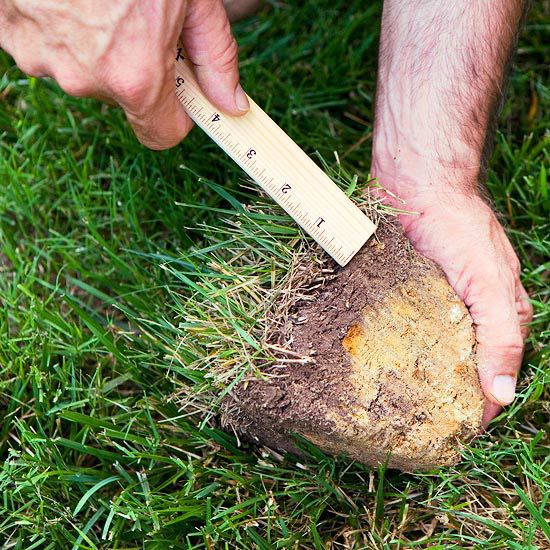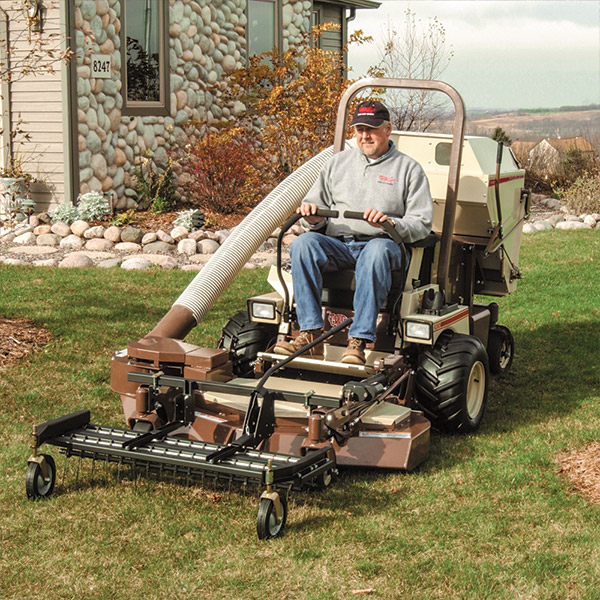Lawn Care Tip of the Month: Dethatching
Posted on:Feb 19, 2016
This is Part II of our Lawn Care Tip of the Month blog series.
Earlier this month, Punxsutawney Phil — that most magnimous of meteorological mammals — came out of his hole in the ground and did NOT see his shadow. Experts (in what, exactly?) tell us this means Winter is drawing to a close and Spring is just around the corner.
Today in Kansas, it's nearly 70 degrees with partly sunny skies; yesterday was similar. It certainly feels like Spring is here. Which means you should take a moment to consider this month's Lawn Care Tip...Dethatching.
Lawn Care Tip: Why Dethatch your lawn.
Thatch build up is a normal process in the turf life cycle. Your lawn is comprised of a below-ground root system and an above-ground leaf or shoot. Thatch is the accumulation of leaves, stems and roots in a tightly woven layer beneath the shoots, but above the roots. It can form a natural protective barrier against drought, heat and soil compaction, which can improve turf health.
However, when this layer gets too thick and dense, it smother the lawn, blocking essentials such as water, nutrients, air and sunlight. The roots can also begin to grow in the thatch layer instead of the soil, which creates a shallow root zone suceptible to heat and disease.
 Excessive thatch build up occurs when the turf creates organic material faster than that material can decompose. The biggest contributors are roots, stems, crowns — parts of the plant most resistent to decay. This can be a result of too much water, too much nitrogen fertilizer, highly acidic soils, minimal microbe activity or a combination of each.
Excessive thatch build up occurs when the turf creates organic material faster than that material can decompose. The biggest contributors are roots, stems, crowns — parts of the plant most resistent to decay. This can be a result of too much water, too much nitrogen fertilizer, highly acidic soils, minimal microbe activity or a combination of each.
A common misperception is that mulching grass clippings contributes to thatch build up. This is not the case. These smaller grass clippings are composed of mostly water and cellulose, and decompose quickly, returning beneficial nutrients to the turf.
Lawn Care Tip: How to Dethatch your lawn.
First, determine if thatch needs to be removed. The best way is to core a sample from the lawn and measure the space between the soil and the shoots. If the thatch layer is thicker than three-quarters (¾) of an inch, it's time to do some work.

The amount of area you need to dethatch will determine the method and tools. For small spaces, a rake with hard tines should do the trick; plus, a little exercise never hurt anybody. Specialized dethatching rakes are also a good option, with hardened, sharpened tines that penetrate to the soil surface and slice the material in the thatch layer. With a dragging and lifting motion, you will pull the loosened material up and out on to the turf. Be sure to clear the thatch from the lawn. Due to its organic nature, thatch material would be a great addition to a compost pile.
If the area is larger, or if the thatch layer is especially dense, consider a power rake, such as the Tine Rake Dethatcher for your Grasshopper mower. This dethatcher features spring steel tines that create a unified raking motion to remove large amounts of thatch while surface aerating the soil. Used in conjunction with a PowerVac™ Collection System, you can dethatch and collect debris in one pass.
Lawn Care Tip: When to Dethatch your lawn.
Now you know the why's and how's of dethatching, but when do you dethatch your lawn? This all depends on the type of grass.
If your lawn is composed of warm-season grasses, such as bermudagrass or zoysiagrass, you want to dethatch in the spring, once the grass has come out of dormancy, but before it really takes off. Do not dethatch in the fall when these grasses are transitioning into dormancy.
For cool-season grasses, such as fescues and Kentucky bluegrass, you can dethatch in early spring or early fall, as these are the times just before peak growing periods. When dethatchin in the fall, allow time for the grass to recover before the first frost.

